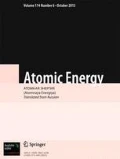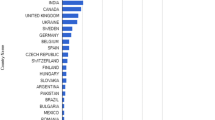Abstract
In the paper are given the results of calculations on the study of the effect of the temperature of the neutron gas on the length of run of a reactor, the breeding of Pu239 and the quantity of electrical energy generated. The calculations were carried out on a basis conforming to two alternative cores of a uranium-graphite reactor with sodium coolant: with zirconium-clad fuel elements (alternative I) and steel-clad ones (alternative II). It was established that for reactors of a given type, the most economically suitable temperature for the neutron gas is 900 ° to 1000 °K.
Investigations on the dependence of the run time of the reactor and the breeding factor on the neutron gas temperature were also carried out for two other types of reactors- the homogeneous sodium-graphite and the heterogeneous uranium-graphite with gas coolant. The results of the calculations are offered in the form of graphs.
Similar content being viewed by others
Literature cited
E. Kogen, Experimental reactors and the physics of reactors (lectures of foreign scientists at the International Conference on the Peaceful Uses of Atomic Energy), (Gostekhlzdat, 19561 page 257.
D. I. Blokhintsev, M. E. Minashin, Iu. A. Sergeev, Atomnaia Energla, No. 1, 24 (1956).
Rights and permissions
About this article
Cite this article
Krasin, A.K., Minashln, M.E. & Sviridenko, V.I. The effect of the temperature of the neutron gas on the length of run and fuel breeding in a power reactor. The Soviet Journal of Atomic Energy 5, 943–950 (1958). https://doi.org/10.1007/BF01587528
Received:
Issue Date:
DOI: https://doi.org/10.1007/BF01587528




